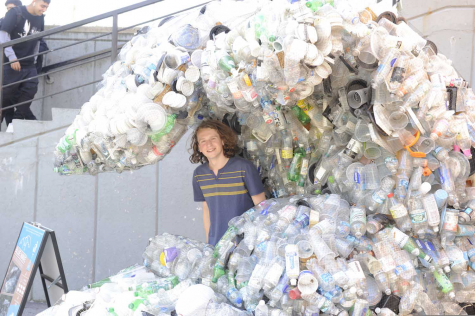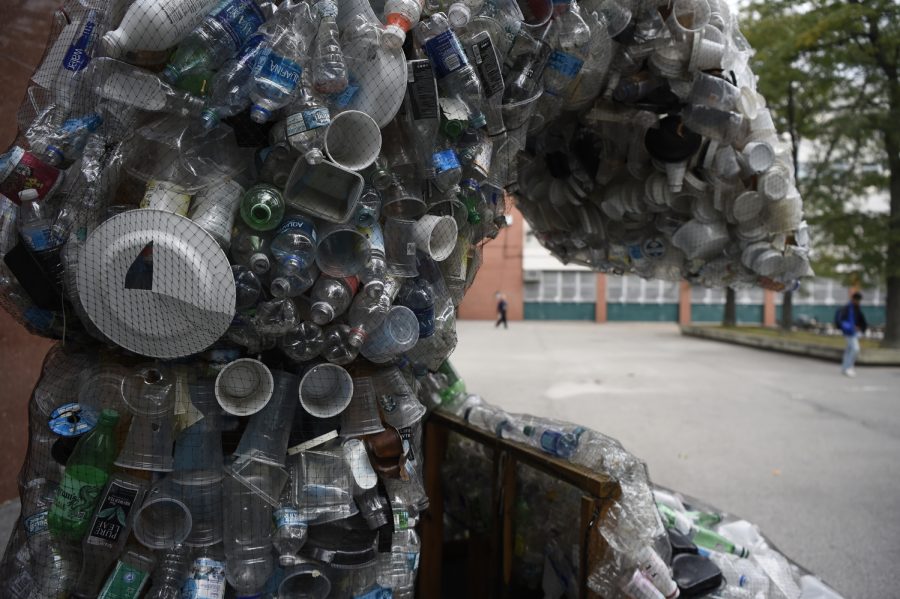Waving Goodbye to Ocean Pollution
The Bronx Science Green Team is taking initiative by bringing attention to the issues of plastic in the ocean through the Pratt Institute’s Blue Wave sculpture
An up-close view of the components of the Blue Wave, various forms of plastic waste gathered over a twenty-four hour period.
As you climb off your Vallo bus, eyes bleary and stomach grumbling, a large shape in the Bronx Science courtyard catches your eye. On your walk up to school, you identify the shape as an artistic interpretation of a large wave, different shades of blue standing out in the dark entrance. Upon closer inspection, you can see the wave is a sculpture made up of various forms of plastic waste, held together by a mesh sheet. As the student body passes this sculpture daily when heading into school, they may notice elements of plastic in that sculpture they use in their own daily life, showing them the harm that the products they use cause the environment.
The temporary display presented by the Bronx Science Green Team raises awareness to the continuously growing issue of plastic in the ocean, and the harm it causes to marine life. While many people believe Bronx Science is more focused on STEM subjects and less to the arts and environment, this is an inaccurate assumption. The diversity of our student body brings every aspect of learning to the school. The blue wave sculpture is a prime example of Bronx Science supporting students’ passion for the arts and the well-being of the environment. Green Team member Haley Sim ’20 said, “The sculpture is made up of twenty-four hours’ worth of hard plastic trash, and I believe it brings light to the important issue of waste and plastic overuse in our modern day and age in an aesthetically pleasing and creative way.” This perspective on the sculpture reveals the targeted interests the wave portrays, and the positive messages it sends to students.
The Blue Wave Movement, started by artist Samuel Pressman, was a collaboration between the summer climate institute at Bronx Science and the Pratt Institute. The wave was built by students from the graduate center for planning and the environment, and the leaders of environmental advocacy at Pratt. They used twenty-four hours’ worth of plastic waste from the Pratt Brooklyn campus to construct the sculpture. The temporary display stands as a reminder of the issues that plastic waste causes to the environment and provokes thought on how to change and fix harmful behavior. Green team member Kin Yang ’20 said, “The sculpture inspires its viewers to rethink their lifestyles, and how they can reduce their dependence on plastic products. The sculpture is a symbol of how wasteful and oblivious people have become when it comes to using single-use plastic items.” The sculpture creates a message that is hard to ignore, as it stands outside the entrance to the school and shows just how much plastic is wasted on one campus in one day.

Plastic is one of the most common ocean pollutants, and impacts nearly 700 different species. While an estimated 150 million metric tons of plastic currently circulate the ocean, it is estimated that each year another 8 million metric tons of plastic enter the marine environments. Plastic has been identified in all sea turtle species, as well as more than 60% of all seabirds. The undeniable problem that plastic waste creates in the ocean is hard to tame, as many of the products people unknowingly use in their daily life end up in the ocean as plastic waste. Yang said, “Although convenient and relatively cheap, plastic products are often not recycled properly and end up in the ocean, breaking up into micropellets and ending up in marine life.”
While the issue may seem unbeatable, there are ways to change our behavior and clean up the ocean. The three main ways plastic ends up in the ocean are through throwing plastic in the trash rather than recycling it, littering, and products being flushed and going down the drain. By avoiding these actions and raising awareness through displays like the blue wave, less plastic would end up in the ocean and people would be more conscious of their own plastic usage. When being asked about his thoughts on the sculpture, Jakob Cheng ’22 said, “I think the Green Team wave sculpture represents the change in tide of how we as a community need to change our bad habits of littering and not recycling recyclable material for the future of the world’s climate and the human population.” Many people do not realize the impact that they have on the environment as individuals, and it’s important to recognize how our actions can affect the world around us. The overwhelmingly positive reaction to the blue wave and the messages it sends to students shows just how impactful an art piece like this one can be. The Green Team members have said that students should expect more installments in the future, and they are hoping to find opportunities to promote sustainability throughout the school year.
Ellora Klein is a Copy Chief for ‘The Science Survey.' She enjoys exploring different perspectives through writing, editing, and reading. Ellora chose...
Jackson Trauben is a Photo Editor and Chief Photographer for ‘The Observatory.’ An avid reader and artist, Jackson loves using photography as a lens...

